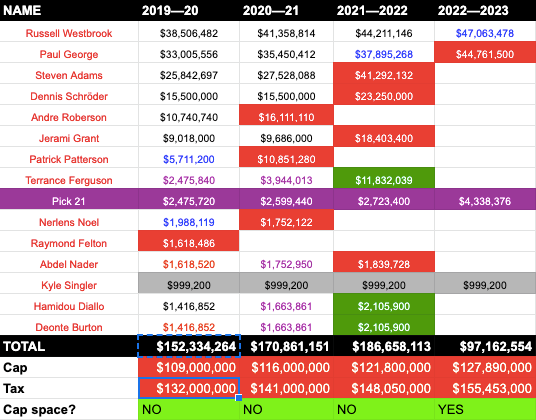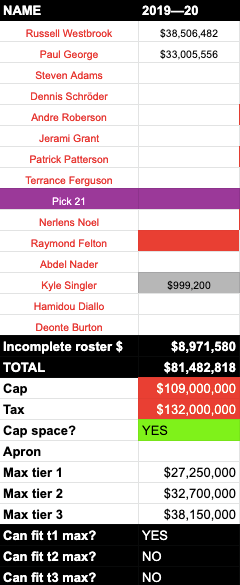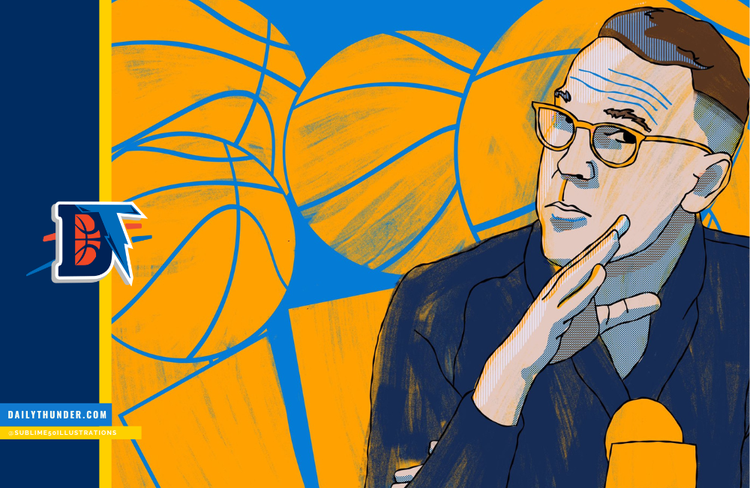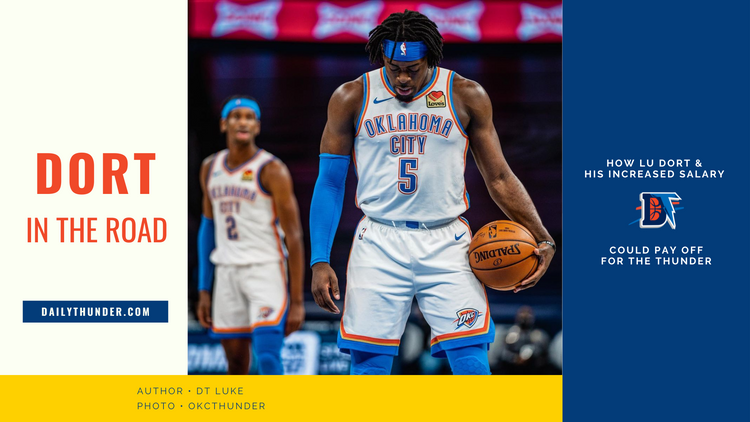The 2019 Thunder Salary Cap Primer

This summer is a huge watershed for not just the Thunder, but the entire NBA.
2019 is ripe for player movement. With Kawhi Leonard, Kevin Durant, Kemba Walker, Jimmy Butler and more coming into free agency, there are a huge number of players who could make a huge difference for whatever team they sign for.
What about the Thunder, though?
Fans of any sports league want their team to have the best players possible. The Thunder’s diehard fanbase is no different. You may have heard the takes already.
“The Thunder should go get Jimmy Butler! He’d be the perfect guy to play next to PG and Russ.”
“What if KD came back? How crazy would that be?”
There are a lot of things that would be great if they’d happen. But the Thunder have to contend with the salary cap, which limits them in terms of what they can do. This offseason will be one of the most pivotal in Thunder history, and it’s going to take every bit of skill in Sam Presti’s bag to come out of this summer with something good.
So without further ado, what can the Thunder do this summer?
Can the Thunder sign Kevin Durant? Or another max contract player?
No.
What about a sign and trade?
No.
Why?
The NBA isn’t like the NFL—it has a soft cap, not a hard cap. This means that you can go over the cap with certain exceptions. But once you’ve done that, you’re dramatically more limited in what you can do to build your team.
This isn’t a deal-breaker. Most championship contending teams are over the cap. Most borderline teams tend to be over the cap too—it’s fairly common. In fact, every team in the NBA is over the cap this season. Even this coming offseason, 18 of 30 NBA teams are projected to be over the cap, per capologist Keith Smith’s salary guide.
What sets the Thunder apart is how far they are over the cap. They’re far enough over that they’re in the luxury tax. Contrary to popular opinion, the salary cap and the luxury tax are separate lines—you can be over the cap but under the tax. The Thunder are so far above the tax line that they’re unlikely to get back under, let alone reach the cap.

To put it in perspective, the Thunder’s payroll is projected at $152,334,264 this offseason, with very little way to cut. That puts them $43,334,264 over the projected cap and $20,334,264 over the projected tax line.
If you’re that far over the cap, the only tools you realistically have to sign players are the Taxpayer Mid-Level Exception (projected around $6 million) and the Minimum Player Salary Exception (around $1–2 million).
Well, what about sign and trades?
Ah, the sign and trade, the bane of every capologist’s Twitter experience. It’s an easy, glib rejoinder to “this team doesn’t have cap space to sign X player”.
Here’s why it doesn’t work for OKC.
You remember the thing about the NBA’s salary cap being a soft cap? That usually applies, but there are a few exceptions that invoke a hard cap. One of those is receiving a player that’s signed and traded.
When a team receives a player in a sign-and-trade in 2019, it will be hard capped at the apron, a point roughly $6 million above the tax line. The Thunder are still around $15 million above the apron, which makes it basically impossible for them to accomplish.
Could they dump a player to do it? Like, say, Steven Adams or Dennis Schröder? Or cut someone?
Probably not.
Firstly, to be able to carry off the sign and trade, they need salaries to match. And those salaries have to be for players that the other team actually wants. Adams and Schröder are the most tradeable of those salaries, and to even get to the point where you could do a sign and trade you’d probably have to dump them.
Could you do it by trading away, say, Patterson and Roberson? Sure. But those two would require significant incentive for a team to take them on for nothing in return, and the Thunder doesn’t have much to give. And then you have to fill out a 15-man roster afterwards while remaining under the hard cap, which would be a borderline impossible task.
Adams and Schröder may be tradeable. But dumping their entire salary for nothing in return? Unlikely. For one thing, there aren’t that many teams with enough cap space to absorb either without sending salary back. For another, those teams have to want those players. Both have some value, but both have warts. Adams is slightly overpaid for his production and fills the NBA equivalent role of the running back position—an important one to be sure, but one that has a ton of guys available for cheap that can provide you with 80% of what he does. Schröder’s in a similar boat.
And cutting players? That doesn’t work the same way as other leagues. In the NBA, almost all salaries are guaranteed. You cut a player and you pay their whole salary, and it still counts against the cap. Sure, you could waive and stretch, but the Thunder already have the Singler dead money on their cap. It’s a safe bet they don’t want any more.
OK, so what would it take for us to get below the tax or the cap?
You might want to sit down for this.
Send out Steven Adams for nothing in return. Now you’re under the tax.
Send out Dennis Schröder for nothing in return.
Send out Patrick Patterson for nothing in return.
Congratulations, you’re under the cap.
You don’t have enough space to do anything with it, though. And even less than you think given that the NBA imposes a minimum cap hold for every player you go under 12 on the roster.
If you wanted to sign a max salary player, you have more salary to send out.
Send out Andre Roberson for nothing in return.
Send out Jerami Grant for nothing in return.
Trade away the 21st pick so you don’t have to deal with the cap hold
Let Raymond Felton walk.
Cut Abdel Nader.
Cut Deonte Burton.
Decline Terrance Ferguson’s option or trade him away.
Trade away Hamidou Diallo.
Trade away Nerlens Noel if he opts into his contract.

Congratulations, you’re able to make an offer to the first tier of max contract player, the restricted free agents. That means guys like D’Angelo Russell and Kristaps Porzingis, whose teams will likely match them anyway—and they have first right of refusal. It’s mostly useless because those guys almost never change teams.
You still cannot sign guys like Kevin Durant, Jimmy Butler or Kyrie Irving. Westbrook and George’s contracts take up too much space.
This is the cold hard reality facing the Thunder this offseason. Free agency is almost completely out of the picture as a way to improve the team. That’s not necessarily a bad thing—the Mavericks have spent years betting on free agency and losing, among other teams. Free agency is a gamble. Still, the Thunder are unique in terms of how far they are from being able to make space.
Given current salaries, the first year the Thunder will have cap space is maybe 2021, probably 2022.
You’re kidding! Do you have ANY possible way the Thunder could get an impact player in 2019?
There are a few players that have options that they could opt into if they wanted to do a trade. Kevin Durant is one. That would involve the team trading the player away getting something back they liked, though, and without touching Russ and PG that’s unlikely.
There are players available in trade, as always. That’s the only chance you have of getting a big-name player. But the Thunder have very limited trade assets.
In terms of young players that might have some cachet with other teams, you have Terrance Ferguson and Hamidou Diallo, who both are of fairly negligible value.
In terms of picks, per Eric Pincus of Basketball Insiders the Thunder have their 2024 first-round pick and second-round picks for most future draft years. They don’t have their 2020 or 2022 first-round picks. Because of something called the Stepien Rule, the Thunder can’t trade the picks in between those. (They could do pick swaps, but those are rare and often dangerous.) And if they wanted to pull off a trade at the draft, they could send the rights to whatever player they draft with the 21st pick this year.

So in terms of assets they can send out, they’re extremely limited. That means any value to be sent out in a trade package has to come from the players themselves. Unless a team falls in love with a guy (see: the Sacramento Kings and Buddy Hield) none of the guys on the Thunder’s roster except Russ and PG are capable of being the centerpiece of a trade for a big-name player.
So the Thunder are out of options?
Not necessarily.
Sam Presti is a very good general manager, and he’s pulled a rabbit out of his hat before. But he’s working with very limited assets and he doesn’t have much he can do.
If I were a betting man, I’d put my money on some of the Thunder’s supporting players being moved for greater depth. Steven Adams is the obvious candidate, but Dennis Schröder and Jerami Grant might be possibilities too. If Andre Roberson and Patrick Patterson are involved they’ll probably only be salary ballast to make a trade work.
That’s a hard ask, especially given neither Schröder nor Adams is a particularly valuable archetype in today’s NBA. Adams in particular is a good player, but not one who’s likely to fetch a ton in trade, especially if the Thunder are also trying to cut salary to get away from the tax.
The best bet for this coming year is that we’ll see a very similar Thunder team to the one we saw this year, only hopefully healthier. Sam Presti will try to find wing depth, and that quest will probably determine how successful this offseason is. With the taxpayer mid-level exception and minimum exception as his only tools, though, it’s a tall ask.
We’ll see what happens. As it is at the moment, though, the Thunder are very capped out, unlikely to make their way under the tax, and don’t have much in the way of trade assets. They can’t do much in free agency and their options in trade are limited.
Barring Sam Presti pulling off a miracle, significant internal development or stellar injury luck, the Thunder next year will probably resemble the Thunder this year: a good but flawed team that’s unlikely to make it to the big show.
Here’s hoping that’s not true.



